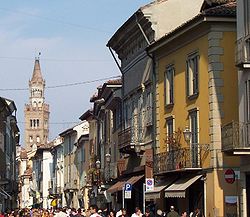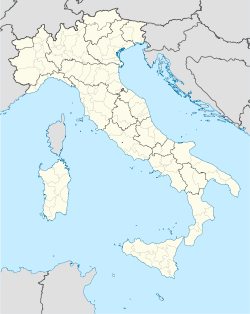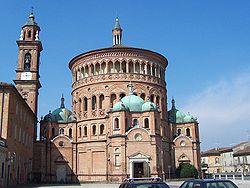- Crema, Lombardy
-
Crema — Comune — Città di Crema A view of a central street in Crema. 
Coat of armsLocation of Crema in Italy Coordinates: 45°22′N 9°41′E / 45.367°N 9.683°E Country Italy Region Lombardy Province Cremona (CR) Frazioni Santa Maria dei Mosi, Santo Stefano in Vairano, Vergonzana Government – Mayor Bruno Bruttomesso (since May 28, 2007) Area – Total 34 km2 (13.1 sq mi) Elevation 79 m (259 ft) Population (1 October 2008) – Total 33,814 – Density 994.5/km2 (2,575.8/sq mi) Demonym Cremaschi Time zone CET (UTC+1) – Summer (DST) CEST (UTC+2) Postal code 26013 Dialing code 0373 Patron saint Saint Pantaleo Saint day June 10 Website Official website Crema is a town and comune in the province of Cremona, in the region of Lombardy in northern Italy. It is built along the river Serio at 43 km from Cremona. It is also the seat of a Catholic Bishop, who gave to Crema the title of city. Crema's main economic activities traditionally relate to agriculture and cattle breeding, but Its manufactures include now cheese, iron products and cotton and wool textiles. Inhabitants are called cremaschi, singular cremasco.
History
Crema's origins have been linked to the Lombard invasion of he 6th century CE, the name allegedly deriving from the Lombard term Krem meaning "little hill", though this is doubtful since it does not lie significantly above the surrounding countryside. Other linguistic roots may suggest an older origin, in particular the Indo-European root meaning a boundary (cf. Ukraine, crêt). Other authorities trace its foundation back to the 4th century CE, when Milan was capital of the Western Roman Empire. According to another version, it was instead an even more ancient Celtic or Etruscan settlement.
Crema first appears in historical documents in the 11th century as a possession of the counts of Camisano. It was then ruled by Boniface, margrave of Tuscany, and his daughter Matilde. In 1098, Matilde gave the town as a gift to the Bishop of Cremona. During this period the prosperity of Crema's territory began as agriculture was boosted and the Humiliates' Order introduced the processing of wool, which was to be the area's main economic activity until the 19th century.
In 1159, after it had signed an alliance with Milan against the Ghibelline Cremona, Crema was besieged, stormed and destroyed by the Emperor Frederick Barbarossa. The siege of Crema was marked by several episodes of brutality. The Germans hung some Cremaschi prisoners to their siege machines hoping the defenders would not fire against their fellows. However, this expedient did not work, and turned the battle into a slaughter.
After the Peace of Constance (1185) the city was allowed to be rebuilt as a castrum ("castle"). Henry VI gave it back to his allied Cremonese. A period as a free Commune followed, during which, however, the tendency to partisan struggles, typical of the northern Italian communes of that age, soon showed. In any case, the city was reinforced with new walls, ditches and gates (1199), and a network of canals further improved agriculture. In the 13th century Crema was also enriched with its famous Cathedral and the Palazzo Pretorio.
The communal independence ended in 1335, when the city surrendered to Gian Galeazzo Visconti, whose family held the city until the end of the century. In 1361 Crema was touched by the Black Death. A brief period of rule by the Guelph Benzoni family followed (Bartolomeo and Paolo from 1403 to 1405, then their nephew Giorgio until 1423). The seignory passed again to the Visconti, and, from 1449 onwards, to the Republic of Venice.
As a Venetian inland province, Crema obtained numerous privileges and was safe from the economic decline of the nearby Duchy of Milan under the Spanish rule. It kept a substantial autonomy, which allowed a program of new buildings. These included a new line of walls, the rebuilding of the Palazzo Comunale (1525–1533), the Palazzo della Notaria, now Palazzo Vescovile.
The 17th century saw the beginning of the decadence of the city, caused by the decline of its industrial activities, although agriculture continued to flourish. In 1796 an Academy of Agriculture was founded. After the fall of the Republic of Venice in 1797, the French army deposed the last podestà and created a municipality. At first Crema formed the province of Crema-Lodi, but later it was annexed to the province of Cremona. In 1814, Napoleon’s Empire fell apart, and Crema became an Austrian possession.
Crema was annexed to Italy in the Risorgimento. Thenceforth it was a part of the Kingdom of Italy and, after 1946, of the Italian Republic.
Main sights
Crema's main monuments include:
- The Duomo (Cathedral) in Lombard-Gothic style, with a tall bell-tower completed in 1604
- The church of Santa Maria della Croce (St. Mary of the Cross) built in 1493–1500 by Giovanni Battagio
- The church of the Santo Spirito (16th century)
- The Palazzo Comunale ("Town Hall")
- The edit] Sister cities
Categories:- Cities and towns in Lombardy
- Communes of the Province of Cremona
Wikimedia Foundation. 2010.



